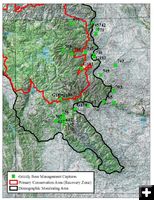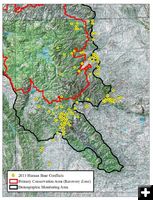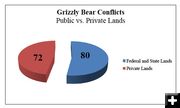

Map 1
Management capture locations (n=27) for grizzly bears captured,
relocated, released, or removed in 2013. Grizzly bears with "G" in front of their number were marked but not wearing radio collars upon release typically because they were too young to be collared. Grizzly bears identified with "NA" were grizzly bears removed from the population without being given an identification number. The "unk" label is the yearling non-target capture released on site.
|


Map 2
Location of human-grizzly bear conflicts in Wyoming outside of National Parks (n = 152) in relation to the Recovery Zone Boundary, Wyoming, 2013. The majority (92%) of documented conflicts in Wyoming occurred outside of the Recovery Zone.
|


Figure 1
Number of Human-Grizzly Bear Conflicts on Private and Public Lands in Wyoming, 2013. Conflicts occurred at similar rates on private lands (47%) versus lands
administered by the State or Federal government (53%).
|
|
Grizzly Bear Research Roundup
by Cat Urbigkit, Pinedale Online!
November 26, 2014
Tracking Human-Grizzly Interactions
Researchers in Grand Teton National Park have been tracking the movement of GPS-collared grizzly bears, seeking to learn how grizzly bears respond to humans. Hunters have long suggested the grizzlies respond to a rifle shot like a ranch crew coming to a dinner bell, with bears approaching hunter-killed elk in anticipation of the gut pile feast left remaining in the field.
According to an article by Brett French of the Billings Gazette, in the first year of research, at least one grizzly bear was found to have followed elk hunters seeking out their game – without the hunters aware that the grizzly was following their movements. The hunters had volunteered to carry GPS units during their day in for elk in Grand Teton’s elk reduction program.
French reported, "At one point, the bear is within 100 yards of the hunters, who never knew it was there."
For more details, read French’s article linked below.
Wyoming Grizzly Bears
The Large Carnivore Section of the Wyoming Game and Fish Department publishes a Job Completion Report for each of its game species annually, and the 2013 Wyoming Grizzly Bear JCR summarizes the agency’s work with the species.
The 2013 report cover includes a mosaic of grizzly bear photos from the year, including an image of the tracks of a grizzly bear as it balanced atop a piece of plastic irrigation pipe to walk across an irrigated field.
Of local interest in the 2013 report is the agency’s summary of research trapping efforts in the Upper Green River/Union Pass area. WG&F began trapping on June 21 and ended July 26, 2013. Three grizzlies were captured in a total of 11 captures, according to the report – one bear was captured nine times.
Here’s the summary of Conflict Management sectiont: "During 2013, the Wyoming Game and Fish Department captured 26 grizzly bears in 27 capture events in an attempt to prevent or resolve conflicts (See Map). Most individuals were lone grizzly bears, but 1 family group (1 female with 2 yearlings) was also captured.
"Of the 27 capture events:
• 15 (56%) occurred in Park County,
• 6 (22%) in Sublette County,
• 3 (11%) in Hot Springs County,
• two (7%) in Fremont County,
• one (4%) in Grand Teton National Park (GTNP), and
• zero in Teton County.
A lone subadult male (#760) was captured by GTNP personnel and was moved to the Boone Creek drainage in Teton County after being caught for frequenting a campground.
"Of the 27 capture events, 18 involved grizzly bears that were relocated from areas preemptively to avoid conflicts or where they were causing property damage, obtained garbage or some non-natural food such as pet food or livestock grain, or a combination of these factors. Thirteen captures were a result of grizzly bears killing livestock, primarily cattle. One management capture was a non-target yearling grizzly bear released on site in Sublette County.
"Eight of the 27 capture events resulted in the removal of grizzly bears from the population by agency personnel due to a history of previous conflicts, a known history of close association with humans, or they were deemed unsuitable for release into the wild (i.e., orphaned cubs, poor physical condition, or human safety concern). All relocated grizzly bears were released on U.S. Forest Service lands in or adjacent to the Grizzly Bear Recovery Zone (RZ).
"Of the 18 relocation events:
• 8 (44%) bears were released in Park County,
• 5 (28%) were released in Teton County, and
• 5 (28%) were released in Fremont County.
The report noted: "Most grizzly bear-human conflicts in Wyoming were a result of domestic livestock depredations and food rewards from humans in the form of garbage or pet and livestock feed. Conflicts, and the resulting capture, relocation, and removal of grizzly bears in WY are generally increasing; however during 2013 the Department did have reduced captures and relocations in comparison to 2011-2012.
"As mentioned earlier, this overall trend is a result of grizzly bears increasing in numbers and distribution into areas used by humans, both on public and private lands. As this GYE grizzly bear population grows and expansion of distribution continues, bears are likely to encounter food sources such as livestock and livestock feed, garbage, and pet food resulting in increased property damage and threats to human safety. Conflict prevention measures such as attractant storage, deterrence, and education are the highest priority for the WGFD. In general, there is an inverse relationship between social tolerance and biological suitability for bear occupancy in areas further from the Recovery Zone due to development, land use patterns, and various forms of recreation. Although prevention is the preferred option to reduce conflicts, each situation is managed on a case-by-case basis using education, securing of attractants, relocation or removal of individual bears, and/or a combination of methods."
The entire WG&F report is linked below.
For readers interested in grizzly bear research and management efforts throughout the Greater Yellowstone Ecosystem, the 2013 report of the Interagency Grizzly Bear Study Team is linked as well.
|


